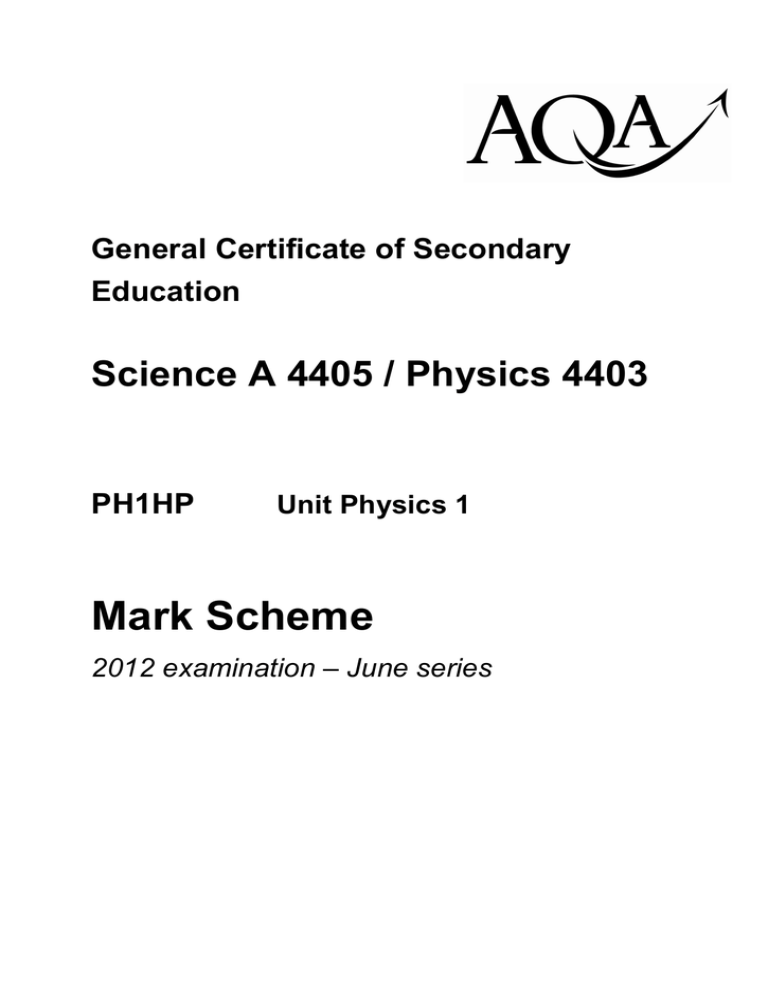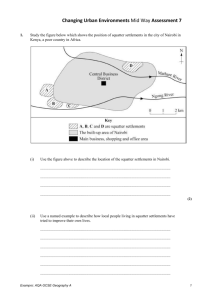
General Certificate of Secondary
Education
Science A 4405 / Physics 4403
PH1HP
Unit Physics 1
Mark Scheme
2012 examination – June series
Mark schemes are prepared by the Principal Examiner and considered, together with the
relevant questions, by a panel of subject teachers. This mark scheme includes any
amendments made at the standardisation meeting attended by all examiners and is the scheme
which was used by them in this examination. The standardisation meeting ensures that the
mark scheme covers the students’ responses to questions and that every examiner
understands and applies it in the same correct way. As preparation for the standardisation
meeting each examiner analyses a number of students’ scripts: alternative answers not already
covered by the mark scheme are discussed at the meeting and legislated for. If, after this
meeting, examiners encounter unusual answers which have not been discussed at the meeting
they are required to refer these to the Principal Examiner.
It must be stressed that a mark scheme is a working document, in many cases further
developed and expanded on the basis of students’ reactions to a particular paper. Assumptions
about future mark schemes on the basis of one year’s document should be avoided; whilst the
guiding principles of assessment remain constant, details will change, depending on the content
of a particular examination paper.
Further copies of this Mark Scheme are available to download from the AQA Website: www.aqa.org.uk
Copyright © 2012 AQA and its licensors. All rights reserved.
COPYRIGHT
AQA retains the copyright on all its publications. However, registered schools / colleges for AQA are permitted to
copy material from this booklet for their own internal use, with the following important exception: AQA cannot give
permission to schools / colleges to photocopy any material that is acknowledged to a third party even for internal use
within the school / college.
Set and published by the Assessment and Qualifications Alliance.
The Assessment and Qualifications Alliance (AQA) is a company limited by guarantee registered in England and Wales (company number 3644723) and a registered charity (registered charity number 1073334).
Registered address: AQA, Devas Street, Manchester M15 6EX
Science A / Physics – AQA GCSE Mark Scheme 2012 June series
MARK SCHEME
Information to Examiners
1.
General
The mark scheme for each question shows:
•
•
•
•
the marks available for each part of the question
the total marks available for the question
the typical answer or answers which are expected
extra information to help the Examiner make his or her judgement and help to
delineate what is acceptable or not worthy of credit or, in discursive answers, to give
an overview of the area in which a mark or marks may be awarded.
The extra information is aligned to the appropriate answer in the left-hand part of the
mark scheme and should only be applied to that item in the mark scheme.
At the beginning of a part of a question a reminder may be given, for example:
where consequential marking needs to be considered in a calculation;
or the answer may be on the diagram or at a different place on the script.
In general the right hand side of the mark scheme is there to provide those extra details
which confuse the main part of the mark scheme yet may be helpful in ensuring that
marking is straightforward and consistent.
2.
3.
Emboldening
2.1
In a list of acceptable answers where more than one mark is available ‘any two
from’ is used, with the number of marks emboldened. Each of the following lines
is a potential mark.
2.2
A bold and is used to indicate that both parts of the answer are required to award
the mark.
2.3
Alternative answers acceptable for a mark are indicated by the use of or.
(Different terms in the mark scheme are shown by a / ; eg allow smooth / free
movement.)
Marking points
3.1
Marking of lists
This applies to questions requiring a set number of responses, but for which
students have provided extra responses. The general principle to be followed in
such a situation is that ‘right + wrong = wrong’.
Each error/contradiction negates each correct response. So, if the number of
error/contradictions equals or exceeds the number of marks available for the
question, no marks can be awarded.
However, responses considered to be neutral (indicated as * in example 1) are
not penalised.
3
Science A / Physics – AQA GCSE Mark Scheme 2012 June series
Example 1: What is the pH of an acidic solution? (1 mark)
Student
Response
1
2
3
4
4,8
green, 5
red*, 5
red*, 8
Marks
awarded
0
0
1
0
Example 2: Name two planets in the solar system. (2 marks)
Student
1
2
3.2
Response
Neptune, Mars, Moon
Neptune, Sun, Mars,
Moon
Marks awarded
1
0
Use of chemical symbols / formulae
If a student writes a chemical symbol / formula instead of a required chemical
name, full credit can be given if the symbol / formula is correct and if, in the
context of the question, such action is appropriate.
3.3
Marking procedure for calculations
Full marks can be given for a correct numerical answer, as shown in the column
‘answers’, without any working shown.
However if the answer is incorrect, mark(s) can be gained by correct
substitution / working and this is shown in the ‘extra information’ column;
3.4
Interpretation of ‘it’
Answers using the word ‘it’ should be given credit only if it is clear that the ‘it’
refers to the correct subject.
3.5
Errors carried forward
Any error in the answers to a structured question should be penalised once only.
Papers should be constructed in such a way that the number of times errors can
be carried forward are kept to a minimum. Allowances for errors carried forward
are most likely to be restricted to calculation questions and should be shown by
the abbreviation e.c.f. in the marking scheme.
3.6
Phonetic spelling
The phonetic spelling of correct scientific terminology should be credited unless
there is a possible confusion with another technical term.
3.7
Brackets
(…..) are used to indicate information which is not essential for the mark to be
awarded but is included to help the examiner identify the sense of the answer
required.
4
Science A / Physics – AQA GCSE Mark Scheme 2012 June series
Quality of Written Communication and levels marking
In Question 8 students are required to produce extended written material in English, and will be
assessed on the quality of their written communication as well as the standard of the scientific
response.
Students will be required to:
• use good English
• organise information clearly
• use specialist vocabulary where appropriate.
The following general criteria should be used to assign marks to a level:
Level 1: Basic
• Knowledge of basic information
• Simple understanding
• The answer is poorly organised, with almost no specialist terms and their use
demonstrating a general lack of understanding of their meaning, little or no detail
• The spelling, punctuation and grammar are very weak.
Level 2: Clear
• Knowledge of accurate information
• Clear understanding
• The answer has some structure and organisation, use of specialist terms has been
attempted but not always accurately, some detail is given
• There is reasonable accuracy in spelling, punctuation and grammar, although there may
still be some errors.
Level 3: Detailed
• Knowledge of accurate information appropriately contextualised
• Detailed understanding, supported by relevant evidence and examples
• Answer is coherent and in an organised, logical sequence, containing a wide range of
appropriate or relevant specialist terms used accurately.
• The answer shows almost faultless spelling, punctuation and grammar.
5
Science A / Physics – AQA GCSE Mark Scheme 2012 June series
PH1HP
Question 1
question
1(a)
answers
extra information
any two from:
mark
2
• black is a good emitter of
(infrared radiation)
accept heat for radiation
ignore reference to absorbing
radiation
• large surface (area)
• matt surfaces are better
emitters (than shiny surfaces)
accept matt surfaces are good
emitters
ignore reference to good
conductor
1(b)
efficiency =
useful energy out (×100%)
total energy in
allow 1 mark for correct
substitution
90 % or 0.9(0)
2
ie 13.5
15
provided no subsequent step
shown
an answer of 90 scores 1 mark
an answer of 90 / 0.90 with a
unit scores 1 mark
1(c)
(producing) light
allow (producing) sound
1
Question 1 continues on the next page
6
Science A / Physics – AQA GCSE Mark Scheme 2012 June series
PH1HP
Question 1 continued
question
1(d)
answers
extra information
any two from:
• wood is renewable
mark
2
accept wood grows again /
quickly
accept wood can be replanted
• (using wood) conserves fossil
fuels
accept doesn’t use fossil fuels
• wood is carbon neutral
accept a description
cheaper / saves money is
insufficient
E=m×c×θ
1(e)
allow 1 mark for correct
substitution
ie 100 × 510 x 50
provided no subsequent step
shown
2 550 000
2
answers of 1 020 000, 3 570 000
gain 1 mark
accept kJ / MJ
joules /J
1
do not accept j
for full credit the unit and
numerical answer must be
consistent
Total
10
7
Science A / Physics – AQA GCSE Mark Scheme 2012 June series
PH1HP
Question 2
question
2(a)(i)
answers
extra information
allow gravitational potential
(energy) / gpe
kinetic (energy)
mark
1
movement is insufficient
2(a)(ii)
dissipates into the surroundings
allow warms up the surroundings /
air / motor
1
accept lost to the surroundings
accept lost as heat
ignore reference to sound
it is lost is insufficient
2(b)
energy (required) increases with
load
accept positive correlation
1
do not accept (directly)
proportional
further amplification eg
increases slowly at first (or up to
4 / 5 N), then increases rapidly
simply quoting figures is
insufficient
1
an answer that only describes the
shape of the line gains no marks
Question 2 continues on the next page
8
Science A / Physics – AQA GCSE Mark Scheme 2012 June series
PH1HP
Question 2 continued
question
answers
extra information
mark
E=P×t
2(c)(i)
2880
accept £28.80 for all 3 marks
3
an answer £2880 gains 2 marks
allow 1 mark for obtaining 48 h or
converting to kW
allow 2 marks for correct
substitution
ie 4 × 48 × 15
note: this substitution may be
shown as two steps
an answer 2 880 000 gains
2 marks
an answer £4.80 / 480 gains 2
marks
an answer of 192 (ie calculation
of energy without subsequent
calculation of cost) gains 1 mark)
2(c)(ii)
1
any sensible suggestion eg
conserves fossil fuels
less (fossil) fuels burned
accept a named pollutant gas
less pollutant gas (produced)
less greenhouse gas (produced)
saves energy is insufficient
Total
8
9
Science A / Physics – AQA GCSE Mark Scheme 2012 June series
PH1HP
Question 3
question
answers
extra information
3(a)(i)
energy from hot rocks in the Earth
accept heat that occurs naturally
in the Earth
mark
1
accept steam / hot water rising to
the Earth’s surface
accept an answer in terms of the
energy released by radioactive
decay in the Earth
heat energy is insufficient
3(a)(ii)
water is pumped / moved
1
up (to a higher reservoir)
this mark point only scores if first
mark point is awarded
3(b)
1
6
Marks awarded for this answer will be determined by the Quality of Written Communication
(QWC) as well as the standard of the scientific response. Examiners should also refer to
the information on page 4 and apply a ‘best-fit’ approach to the marking.
0 marks
No relevant
content
Level 1 (1-2 marks)
Level 2 (3-4 marks)
Level 3 (5-6 marks)
There is a brief
description of at least
one advantage or
disadvantage for either
the planned wind
turbines or the
suggested electricity
power link.
There is a description
of advantages and
disadvantages for
either the planned
wind turbines or the
suggested electricity
power link.
or
A description of the
advantages or
disadvantages for
both the planned wind
turbines and the
suggested electricity
power link.
There is a clear and
detailed description of
at least one
advantage and one
disadvantage for both
the planned wind
turbines and
suggested electricity
power link.
Question 3 continues on the next page
10
Science A / Physics – AQA GCSE Mark Scheme 2012 June series
PH1HP
Question 3 continued
examples of the points made in the
response
extra information
Offshore wind turbines
advantages
•
renewable (energy resource)
•
low running costs
•
energy is free
•
no gas emissions (when in use)
•
land is not used (up)
accept a named gas eg CO 2
accept no fuel is burned
accept less dependent on fossil fuels
disadvantages
•
unreliable – accept wind does not
always blow
•
hazard to birds / bats
•
visual pollution – do not accept
noise pollution
•
difficulty of linking turbines to the
National Grid
•
large initial cost
•
difficult to erect / maintain
•
CO 2 emissions in manufacture
(of large number of turbines)
ignore references to destroying or harming
habitats
do not allow if clearly referring to onshore
wind turbines
do not accept spoils landscape
accept a lot of maintenance needed
Question 3 continues on the next page
11
Science A / Physics – AQA GCSE Mark Scheme 2012 June series
PH1HP
Question 3 continued
examples of the points made in the
response
extra information
Suggested Link
advantages
•
income for Iceland
•
using Iceland’s (available) energy
(resources)
accept using (Iceland’s) renewable energy
(resources)
do not accept reduce the amount of
Iceland’s wasted energy
•
provide electricity when wind does
not blow / reliable
•
provide electricity at times of peak
demand
•
even out fluctuations in supply
•
excess electricity from Britain (windy
days) to Iceland and used to pump
water up to store energy
•
Britain less dependent on fossil fuels
accept Britain needs fewer (new) power
stations
accept conserves fossil fuels
disadvantages
•
large initial cost
•
power loss along a long cable
•
(engineering) difficulties in laying /
maintaining the cable
accept expensive (to lay cables)
accept difficult to repair (if damaged)
Total
9
12
Science A / Physics – AQA GCSE Mark Scheme 2012 June series
PH1HP
Question 4
question
4(a)
answers
extra information
(kinetic) energy (of the particles)
is reduced
accept slow down
accept transfer energy to (cold)
glass / surface
accept energy is lost
mark
1
do not accept vibrate less
1
move closer together
4(b)
double glazing provides (better)
insulation
accept double glazing has a lower
U-value
1
accept less energy / heat transfer
through double glazing
(inside of) glass is not as cold
4(c)(i)
accept window stays warm(er)
any one from:
1
1
• to avoid bias
4(c)(ii)
• to make sure results are
reproducible
accept repeatable / reliable for
reproducible
any three from:
accept Superglaze or G-type for
‘better insulating glass’
throughout
• the lower the U-value, the
better the insulator
‘better insulating glass’ has a
lower U-value is insufficient
3
• better insulating glass costs
more money
• increasing the (width of) air
gap increases cost
• additional cost of better
insulating glass offset by
energy savings
Total
8
13
Science A / Physics – AQA GCSE Mark Scheme 2012 June series
PH1HP
Question 5
question
5(a)
answers
extra information
any two from:
mark
2
• travel (at same speed) through
a vacuum / space
do not accept air for vacuum
• transverse
• transfer energy
• can be reflected
• can be refracted
• can be diffracted
• can be absorbed
• travel in straight lines
5(b)
can pass through the ionosphere
accept atmosphere for
ionosphere
1
do not accept air for ionosphere
accept travel in straight lines
accept not refracted / reflected /
absorbed by the ionosphere
5(c)
diffraction (of waves around hills)
1
wavelength needs to be similar
size to the obstacle / gap
1
radio has a long enough
wavelength or TV doesn’t have a
long enough wavelength
1
an answer TV (waves / signals)
have short wavelengths so do not
diffract (around the hill) scores 2
marks
Question 5 continues on the next page
14
Science A / Physics – AQA GCSE Mark Scheme 2012 June series
PH1HP
Question 5 continued
question
answers
extra information
mark
v=f×λ
5(d)
1.2 × 106 / 1200 000
allow 1 mark for correct
substitution
ie 3.0 × 108 = f x 2.5 x 102
2
hertz / Hz
do not accept hz or HZ
1
accept kHz or MHz
answers 1.2 MHz or 1200 kHz
gain all 3 marks
for full credit the unit and
numerical value must be
consistent
Total
9
15
Science A / Physics – AQA GCSE Mark Scheme 2012 June series
PH1HP
Question 6
question
answers
extra information
6
mark
accept atoms / particles for ions
throughout
(a metal has) free electrons
accept mobile for free
1
(kinetic) energy of (free) electrons
increases
accept energy of ions increases
1
accept ions vibrate with a bigger
amplitude
accept ions vibrate more
do not accept electrons vibrate
more
(free) electrons move faster
accept electrons collide with other
electrons / ions
1
accept ions transfer energy to
neighbouring ions
1
or
electrons move through metal
(so) electrons transfer energy to
other electrons / ions
Total
4
16
Science A / Physics – AQA GCSE Mark Scheme 2012 June series
PH1HP
Question 7
question
answers
extra information
7(a)
two rays drawn from the bulb and
reflected by the glass
angle I = angle R judged by eye
mark
2
allow 1 mark for one incident and
reflected ray even if angle I
doesn’t equal angle R
any conflicting arrows negate this
mark
at least one arrow drawn in
correct direction
1
ignore any arrows drawn on
construction lines behind the
glass
position of image correct
judged by eye
1
Question 7 continues on the next page
17
Science A / Physics – AQA GCSE Mark Scheme 2012 June series
PH1HP
Question 7 continued
question
7(b)
answers
extra information
image is formed by virtual /
imaginary rays crossing
accept construction lines only
show where the light seems to
come from
mark
1
accept the image is behind the
glass / mirror
accept image is seen through the
glass / mirror
accept (real) rays of light do not
pass through the image
accept (real) rays do not cross
accept the image is a reflection
(of the object)
accept the image is formed by
reflection
do not accept a virtual image
can’t be formed on a screen
do not accept the object / image
is reflected
Total
5
18
Science A / Physics – AQA GCSE Mark Scheme 2012 June series
PH1HP
Question 8
question
8(a)
answers
extra information
any three from:
mark
3
• red-shift shows galaxies are
moving away (from each other
/ the Earth)
• more distant galaxies show
bigger red-shift
or
more distant galaxies show a
greater increase in wavelength
• (in all directions) more distant
galaxies are moving away
faster
accept correct reference to
frequency in place of wavelength
accept (suggests) universe is
expanding
• suggests single point of origin
(of the universe)
8(b)(i)
(radiation produced shortly after)
‘Big Bang’
8(b)(ii)
any one from:
accept beginning of time /
beginning of the universe for ‘Big
Bang’
1
1
• can only be explained by ‘Big
Bang’
• existence predicted by ‘Big
Bang’
• provides (further) evidence for
‘Big Bang’
ignore proves ‘Big Bang’ (theory)
ignore reference to red-shift
Question 8 continues on the next page
19
Science A / Physics – AQA GCSE Mark Scheme 2012 June series
PH1HP
Question 8 continued
question
8(b)(iii)
answers
extra information
mark
increase
accept becomes radio waves
1
universe continues to accelerate
outwards
accept as universe continues to
expand
1
or
greater red-shift
Total
7
UMS Conversion Calculator www.aqa.org.uk/umsconversion
20






